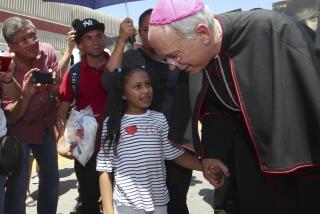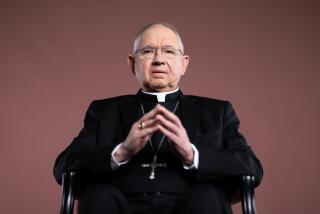Aimed at Making Catholic Parish Life More Appealing : U.S. Bishops Endorse Plan to Keep Latinos in the Flock
- Share via
WASHINGTON — Seeking to counteract the fundamentalist sects and storefront churches that attract many Latinos, U.S. Roman Catholic bishops have endorsed a strategy that they hope will make parish life more intimate and appealing.
Small, supportive groups within parishes need to be formed in greater numbers to make the Latino of Catholic background feel comfortable and respected, according to a plan adopted here by the American hierarchy this week.
The National Pastoral Plan for Hispanic Ministry calls for increasing the number of offices for Spanish-speaking ministries beyond those already created in 130 U.S. dioceses. And it recommends other ways to heighten Catholic awareness of Latino needs and potential.
At the heart of the document is a paradox that Latino leaders want the small groups to address.
On one hand, the Catholic-born Latino already has spirituality alive in home and family, the document says. It may take the form of prayer, songs and sacred gestures or small altars, statues and candles. It is obvious in pilgrimages and processions but also is in personal hospitality and patience amid suffering, the document says. A 1985 study of Catholic Latinos cited in the document also says that 83% consider religion important.
On the other hand, the same study says 88% of Latino Catholics are not active in their parishes. “The poor, men and second-generation Hispanics are those who least participate in the life of the (Catholic Church),” according to the document. By contrast, “Jehovah’s Witnesses, Pentecostal groups and other sects are increasing within the Hispanic community,” the document says.
Bishop Ricardo Ramirez of Las Cruces, N.M., who chaired the four-bishop committee that wrote the pastoral plan, told a news conference during the bishops’ meeting that unless Catholic policies change, “We may lose as many as 50% to sects, or they will simply drop out.”
The writing committee, which drew primarily on conclusions from a 1985 national gathering of Latino Catholic leaders, also included Archbishops Robert F. Sanchez of Santa Fe, N.M., and Roger M. Mahony of Los Angeles.
Sanchez, the immediate past chairman of the bishops’ Committee for Hispanic Affairs, told the assembled bishops that the small communities within the parishes were proposed as “instruments of evangelization.”
That could include knocking on doors, Ramirez said. He said the small parish communities are conceived to be “something like the base communities” popular in Latin America--but with an American touch, connected to the parish.
Sanchez said the plan was not advocating the replacement of traditional church organizations, such as Catholic Boy Scouts.
The plan specifies, however, that the small groups must be “culturally sensitive to the marginalized,” a term frequently used in the document for people who by various circumstances are left out of mainstream society.
San Antonio Archbishop Patrick Flores called the small groups communities “where people can hold on to each other.”
Cardinal Joseph Bernardin, who said that between 800,000 and 1 million Latinos live in his Chicago archdiocese, termed the adoption of the National Pastoral Plan for Hispanic Ministry a critical moment for American Catholicism.
Nationally, more than a third of the 53 million Catholics are Latino, and addressing Latino Catholics was one of the priorities of the recent visit of Pope John Paul II.
Coincidentally, the U.S. bishops also voted this week to ask the Vatican for permission to raise the memorial of Our Lady of Guadalupe to the rank of a feast day nationwide. The Dec. 12 observance, which celebrates the reported apparition of the Virgin Mary to a Mexican peasant, is of major importance to Catholics of Mexican heritage.
The day is already celebrated as a feast day on the church calendar in the Los Angeles archdiocese because Our Lady of Guadalupe is considered one of the “patronesses” of the archdiocese.
More to Read
Sign up for Essential California
The most important California stories and recommendations in your inbox every morning.
You may occasionally receive promotional content from the Los Angeles Times.










